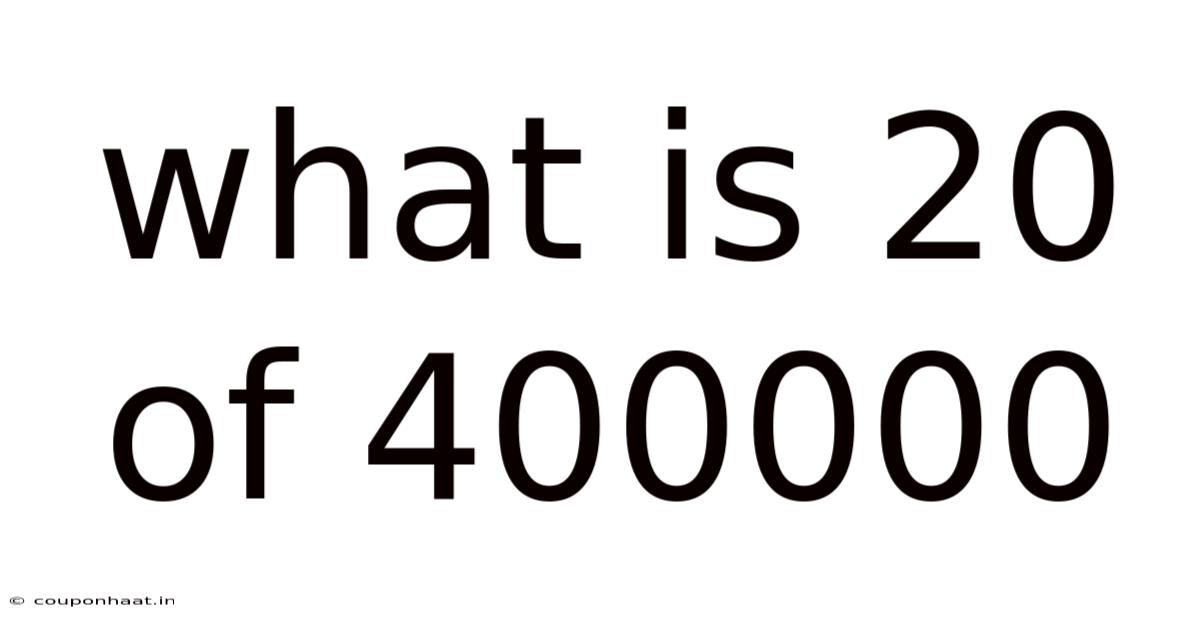What Is 20 Of 400000
couponhaat
Sep 13, 2025 · 4 min read

Table of Contents
What is 20/400,000? Understanding Fractions and Percentages
This article explores the seemingly simple question: "What is 20/400,000?" While the calculation itself is straightforward, understanding the process reveals fundamental concepts in mathematics, specifically fractions, decimals, and percentages. This knowledge is crucial for various applications, from everyday budgeting to complex scientific calculations. We'll break down the calculation step-by-step, explore different ways to represent the answer, and discuss its practical implications.
Understanding Fractions: The Building Blocks
A fraction represents a part of a whole. It's expressed as a ratio of two numbers: the numerator (top number) and the denominator (bottom number). In our case, 20/400,000, the numerator is 20 and the denominator is 400,000. This fraction signifies 20 parts out of a total of 400,000 parts.
Simplifying the Fraction
Before calculating the exact value, simplifying the fraction makes the process easier and the result clearer. We can simplify by finding the greatest common divisor (GCD) of the numerator and denominator. The GCD is the largest number that divides both numbers without leaving a remainder. In this case, the GCD of 20 and 400,000 is 20.
Dividing both the numerator and denominator by 20, we get:
20 ÷ 20 = 1 400,000 ÷ 20 = 20,000
This simplifies the fraction to 1/20,000. This simplified fraction is equivalent to the original fraction, representing the same proportion.
Converting to Decimal:
To express the fraction as a decimal, we divide the numerator by the denominator:
1 ÷ 20,000 = 0.00005
This decimal representation shows the fraction's value as a number less than one. The decimal form is often preferred in many calculations and applications.
Expressing as a Percentage:
A percentage represents a fraction out of 100. To convert the decimal to a percentage, we multiply by 100:
0.00005 x 100 = 0.005%
This means that 20 out of 400,000 represents 0.005% of the whole.
Practical Applications and Interpretations
The value of understanding 20/400,000 extends beyond simple arithmetic. Consider these scenarios:
-
Statistical Analysis: In large datasets, a small fraction like this might represent a specific event's probability or frequency. For example, if 20 out of 400,000 people surveyed preferred a particular product, this represents a low but measurable preference.
-
Financial Calculations: This type of calculation can arise in various financial contexts, such as determining a small percentage of a large investment or calculating the relative contribution of a minor expense to a large budget.
-
Scientific Measurements: In scientific experiments, small fractions are often encountered when measuring minute quantities or calculating probabilities. Accuracy in handling these small fractions is paramount to obtaining reliable results.
-
Proportional Reasoning: Understanding the relationship between 20 and 400,000 helps in solving proportional problems. If 20 items cost X dollars, how much would 400,000 items cost? This kind of problem relies on understanding the fraction's ratio.
Further Exploration: Working with Very Small Numbers
Working with very small numbers, like the decimal 0.00005 or the percentage 0.005%, requires careful attention to detail. These numbers are often best handled using scientific notation or by focusing on the significance of the result in its context. For instance, in a statistical analysis, the context of the data and the sample size will dictate the importance of such a small percentage.
Common Mistakes to Avoid
-
Incorrect Simplification: Failing to find the greatest common divisor can lead to unnecessary complexity in calculations.
-
Decimal Point Errors: When converting between fractions and decimals, careful attention must be paid to the placement of the decimal point to ensure accuracy.
-
Percentage Calculation Errors: Remember to multiply the decimal by 100 when converting to a percentage.
Frequently Asked Questions (FAQs)
-
Q: Can I express 20/400,000 as a ratio? A: Yes, the ratio is 20:400,000, which simplifies to 1:20,000.
-
Q: What if the numerator was larger, say 20,000? A: The calculation would be similar, but the resulting fraction, decimal, and percentage would be significantly larger. You would perform the same steps of simplification, division, and multiplication to obtain the new value.
-
Q: Is there a simpler way to calculate this without simplifying first? A: While you can directly divide 20 by 400,000 using a calculator, simplifying the fraction first makes the process less prone to errors and easier to understand.
Conclusion:
Understanding the concept of 20/400,000 involves more than just a simple calculation. It requires a grasp of fractions, decimals, and percentages – fundamental mathematical concepts with wide-ranging applications. Through simplification, conversion, and contextual understanding, we see that 20 out of 400,000 represents a very small fraction (1/20,000), a tiny decimal (0.00005), and an insignificant percentage (0.005%). However, the process of arriving at this answer teaches valuable lessons about mathematical reasoning and the importance of precision in numerical operations. Mastering these skills equips you to handle more complex calculations and analyze data effectively in various fields. The seemingly simple question "What is 20/400,000?" opens the door to a deeper understanding of mathematical principles and their practical relevance in the real world.
Latest Posts
Latest Posts
-
Sri Guru Nanak Dev Ji
Sep 13, 2025
-
Wildlife Of The Dominican Republic
Sep 13, 2025
-
Why Is Geography Is Important
Sep 13, 2025
-
Add Subtract Multiply Divide Integers
Sep 13, 2025
-
Population San Juan Puerto Rico
Sep 13, 2025
Related Post
Thank you for visiting our website which covers about What Is 20 Of 400000 . We hope the information provided has been useful to you. Feel free to contact us if you have any questions or need further assistance. See you next time and don't miss to bookmark.